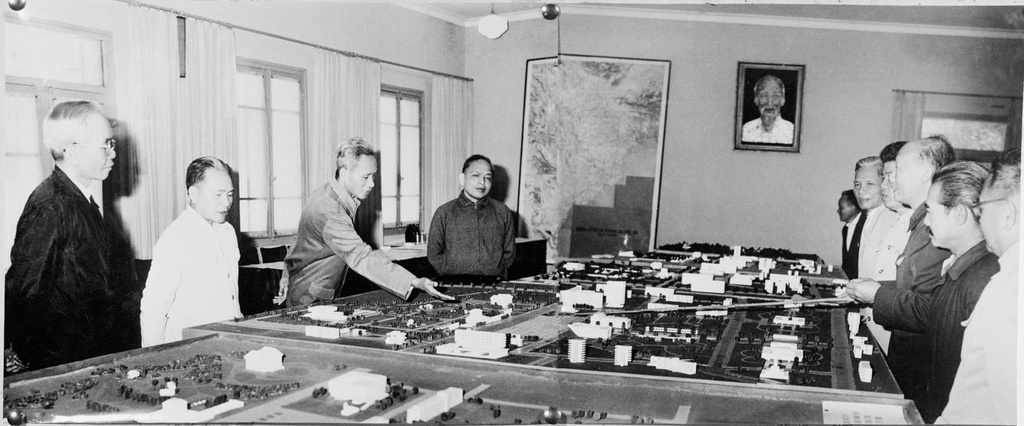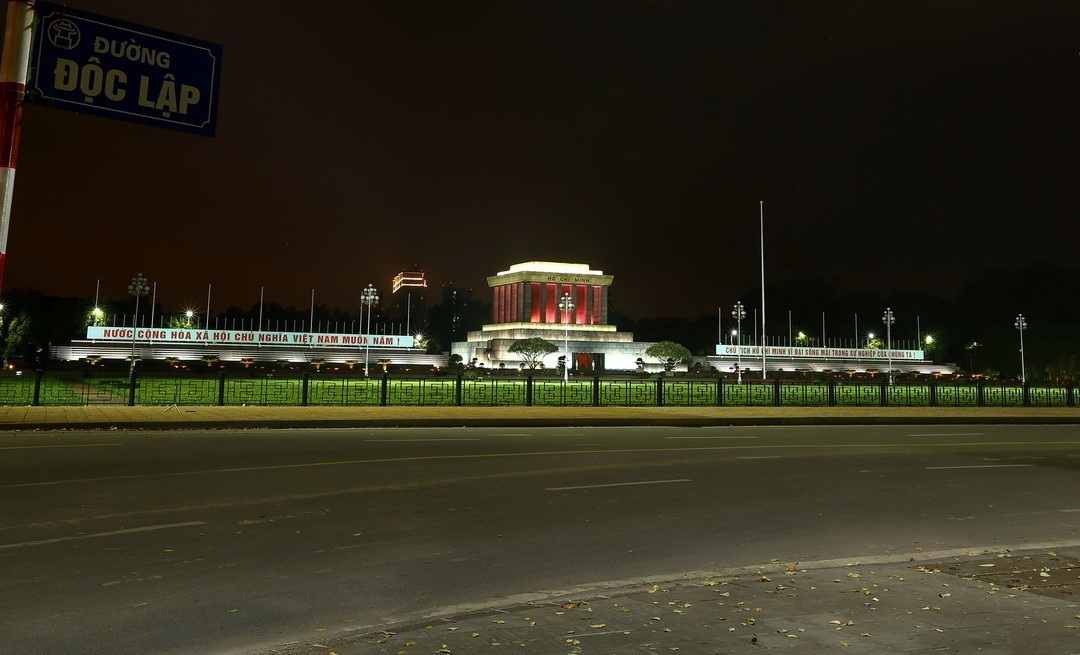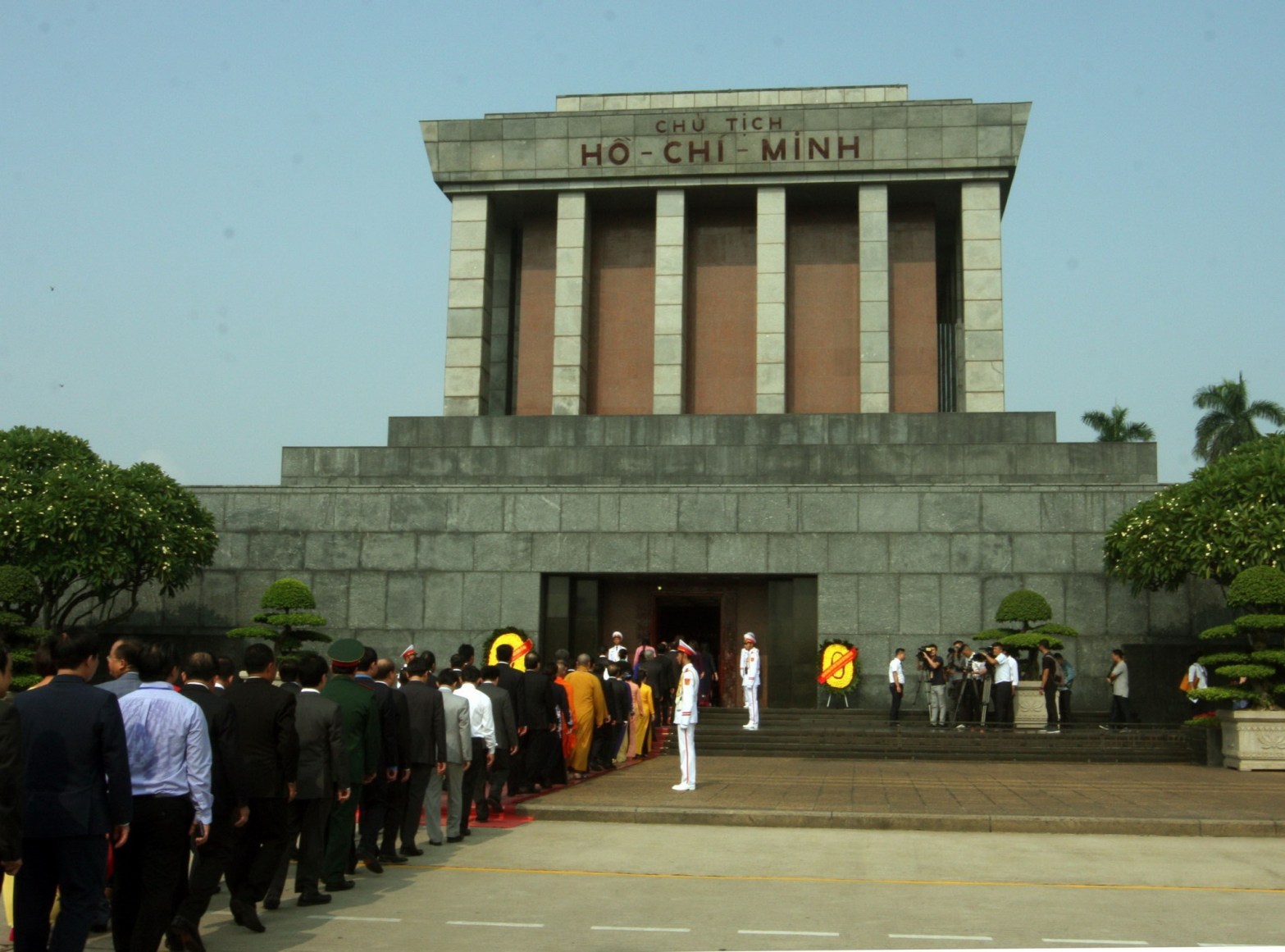Hanoi (VNA) – At the wishes of the Party and people, in the morning of November 29, 1969, the Politburo discussed and decided: With endless love and eternal gratitude to President Ho Chi Minh, we must do our best to preserve his body in a mausoleum.
The Party and State decided to build the mausoleum in the historic Ba Dinh Square, where he read the Declaration of Independence, proclaimed the founding of the Democratic Republic of Vietnam.
Uncle Ho’s mausoleum is both a monumental and a majestic work of architecture; measuring 21.6 metres high, 31 meters wide at the front. It has two gates at the wing sides.
The three-floor foundation of the Mausoleum is paved with dark marble. The upper floor is smaller than the lower one, forming a massive three-tiered structure. The architecture makes a firm and dignified shape for the Tomb.
The mausoleum also has an elegant three-levelled roof with diagonal lines, looking neat and simple, yet modern and traditional.
There are four rows of silver-gray marble pillars around the mausoleum.
On the morning of August 29, 1975, the Party and State solemnly hosted the inauguration of the Ho Chi Minh Mausoleum and let the late President rest in the hearts of the people.
Behind the four marble pillars are four vermilion red marble walls, where late President Ho Chi Minh rests.
After nearly 700 days and nights of constructions, with the help of the Party, Government and people of the Soviet Union, the building was complete.
The Government of the Soviet Union helped build the mausoleum. From February 9-23, 1970, the Government of the Soviet Union sent a delegation of seven officials to Vietnam to discuss the design of the Ho Chi Minh Mausoleum. Within a week, experts from the Soviet Union and Vietnam finished drafting the design.
On October 19, 1970, the draft was adopted at the Politburo session.
For over a month, Vietnamese architects, engineers and technical staff had completed the “draft design” of the mausoleum.

From March 19 to May 6, 1970, a delegation of three Vietnamese architects brought the “draft design” with them and continued the work with Soviet experts. Together, they finalised a design suitable for the tropical climate of Vietnam. This design was dubbed Project 75808.
During the period, donators nationwide and worldwide offered their contributions to the building of the mausoleum. At the wishes of the people, the Politburo of the Central Party decided to postpone the review of the “draft design” to four to five months in order to collect designs of the mausoleum as well as put them on showcase for public poll.
After launching the design campaign, between the end of May to end of August 1970, the Organising board received more than 200 different design projects from 16 units, sectors and individuals. Of which, 24 were shortlisted and displayed in 5 locations, namely Hanoi, Hai Phong, Thai Nguyen, Son La and Nghe An. The exhibition received a total of 745,487 visitors and 34,022 comments.
After 10 days of exhibition, the “preliminary design” synthesising public opinions was brought to the Soviet Union for further review.
February 9, 1971, in Moscow, “the Agreement between the Government of Democratic Republic of Vietnam and the Government of Socialist Republic of Soviet in the Soviet Union providing technical assistance for Vietnam to preserve the body of late President Ho Chi Minh and build the Mausoleum was signed by representatives in the two Governments.
On November 3, 1971, Prime Minister Pham Van Dong signed a decision to officially establish a board in charge of the construction of President Ho Chi Minh Mausoleum. The same day, Deputy Prime Minister Do Muoi signed a decision to establish a command for the construction of Ho Chi Minh Mausoleum.
On December 31, 1971, the technical design of the mausoleum was approved.
Prime Minister Pham Van Dong signed the decision to start the work on September 2, 1973 and complete the work on the same day two years later.
On February 5, 1972, the Prime Minister issued a decision on officially assigning tasks for the ministries, sectors and localities involved in constructing the 75808 project, of which the Ministry of Architecture and Ministry of Defense were the key forces.
The Ministry of Defense was dubbed as Party A of the work (who would manage the work upon the construction completion) and be in charge of interior design. The High Command of Engineering established a regiment for the construction and assembly, named Regiment 259B (or Doan Ba Dinh).
“Prime Minister Pham Van Dong signed the decision to make September 2, 1973, the commencement date and September 2, 1975, the completion date and put the project into operation.”
On the night of June 18, 1973, the entire construction site began to be closed and ready for construction.
On September 2, 1973, the groundbreaking ceremony of Uncle Ho’s mausoleum was conducted.
After 60 days and nights of continuous work, the excavation of the mausoleum’s foundation was completed.
On October 30, 1974, the last concrete batch at the roof of the mausoleum was in place.

President Ho Chi Minh’s Mausoleum is cultural and artistic work. The decoration and finishing work, which requires skill and expertise, takes more than half of the construction time. The entire structure is mainly decorated with marble.
On November 1, 1974, the first marble was tiled in the living hall. The work continued on other walls and rooms in different styles and colours, in harmony with the general layout. The words “President Ho Chi Minh” on the roof of the mausoleum were crafted with Cao Bang jade. The main door of the mausoleum was covered with polished black stone.
The gilded words “Nothing is more precious than independence and freedom” and President Ho Chi Minh’s signature is highlighted on the pink marble background.
The room where President Ho Chi Minh rests is covered with marbles in Ha Tay province, arranged vertically from the wall foot to the ceiling. The two flags: the Party flag and the national flag are assembled with 4,000 ruby pieces from Thanh Hoa province. The hammer and sickle and the star are made of bright yellow marble.
The work has 200 doors skillfully made by carpenters from Nam Ha, Ha Bac, Nghe An provinces.
Ho Chi Minh Mausoleum features many modern systems to preserve the body of late President Ho Chi Minh.
From September 1973, a delegation of electrical, water supply and drainage, ventilation, air-conditioning and mechanical technicians took a study tour to the Soviet Union to gain international expertise in their fields, thus applying in the mausoleum construction. The technical work for the mausoleum was completed by December 1974.
The central air-conditioning system, which is considered the lungs of the project, was designed by the Soviet Union and jointly produced by a number of other countries.
The mausoleum has three water supply and drainage systems with five water tanks with capacity from 10 to 50 cubic metres, nearly 50 pumps of all kinds, more than 450 valves and 5,000 meters of water pipes.
Among the most important types of machinery and equipment is a coffin, installed by experts. The coffin is transparent and closed. Coffin lifting machines also works with precision. There are 20 types of multi-beam lamps, with colours refracted by multiple prisms.

Along with the design and construction of the President Ho Chi Minh Mausoleum, the design, renovation and reconstruction of Ba Dinh Square was carried out.
The Ba Dinh Square, the flower garden and Ho Chi Minh Mausoleum measures 14 hectares. The square in front of the Mausoleum has an area of 20,000 square metres, with 176 grass-grown squares, separated by 1.4 metre-wide passageways. From March 14 to July 17, 2000, the lawn was equiped with an automatic sprinkler system. The Square is surrounded by pavements, which measure 7,800 square metres. Under the ground is the drainage system. Water is collected from the two underground pumping stations.
Hung Vuong Street, which runs in front of the Mausoleum, is made of reinforced concrete, 1,060 metres long. The section in front of the Mausoleum is 60 metres wide. Bac Son Road is 280 metres long, 60 metres wide, divided into two lanes, with a 12-meter-wide flower garden in the middle. Ba Dinh Street is 400 metres long and 18 metres wide. There is also a road around the Mausoleum that exits and enters on both sides and behind the mausoleum.
The square uses high pressure mercury lamps placed on tall columns.
The square also has an information system, radio and television, thus ensuring communications, radio and television broadcasting in place.
Trees, landscaping and flower gardens give fresh air for the entire area of the mausoleum and Ba Dinh Square. With an endless love for late President Ho Chi Minh, people from all walks of life sent trees and flowers to be grown on the land./.

